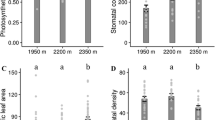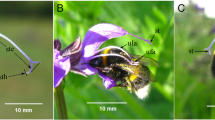Abstract
The evolutionary causes of sexual dimorphism in plants have not been as widely studied as in animals and the importance of sexual selection in causing dimorphism remains controversial. Sexual selection is most obvious when it favours the evolution of a trait which enhances mating success at the expense of decreased viability. We studied the relationship between floral display (number of inflorescences), pollinator attraction and plant survival in a dioecious shrub, Leucadendron xanthoconus. Pollinator attraction, measured as the number of insect pollinators, increased linearly with floral display in males. However, males with extravagant displays had a higher probability of dying. Our data suggest that male plants are undergoing selection on floral display for increased mating success counterbalanced by selection against plants with extravagant displays. Seed set in females did not increase with floral display, except at very low inflorescence numbers. Nor was female survival correlated with floral display. Because inflorescences are terminal in the species, selection for more inflorescences in males causes increased ramification, thinner terminal branches and smaller leaves. Thus vegetative dimorphism in this species appears to be caused by selection for extravagant floral display in males, but not females. Limits to dimorphism are imposed by survival costs of elaborate display.
Access this article
We’re sorry, something doesn't seem to be working properly.
Please try refreshing the page. If that doesn't work, please contact support so we can address the problem.
Similar content being viewed by others
References
Andersson, M. (1994) Sexual selection. Princeton University Press, Princeton, New Jersey.
Bawa, K.S. (1990) Evolution of dioecy in flowering plants. Ann. Rev. Ecol.Syst. 11, 15–39.
Bierzychudek, P., Eckhart, V. (1988) Spatial segregation of the sexes of dioecious plants. Am. Nat. 132, 34–43.
Bond, W.J., Midgley, J. (1988) Allometry and sexual differences in leaf size. Am. Nat. 131, 901–910.
Bond, W.J., Vlok, J., Viviers, M. (1984) Variation in seedling recruitment of Cape Proteaceae after fire. J. Ecol. 72, 209–221.
Bond, W.J., Maze, K., Desmet, P. (1995) Fire life histories and the seeds of chaos. Ecoscience 2, 252–260.
Brown, P.J., Manders, P.T., Bands, D.P., Kruger, F.J., Andrag, R.H. (1991) Prescribed burning as a conservation management practice: a case history from the Cederberg mountains, Cape Province, South Africa. Biol. Conserv. 56, 133–150.
Burd, M. (1994) Bateman's principle and plant reproduction: the role of pollen limitation in fruit and seed set. Bot. Rev. 60, 83–139.
Charlesworth, D., Schemske, D.W., Sork, V.L. (1987) The evolution of plant reproductive characters: Sexual versus natural selection. In S.C. Stearns (ed.), The Evolution of Sex and Its Consequences pp. 317–336. Birkhauser, Basel.
Cipollini, M.L., Whigham, D.F. (1994) Sexual dimorphisms and cost of reproduction in the dioecious shrub Lindera benzoin (Lauraceae). Am. J. Bot. 81, 65–75.
Clark, J.S. (1991) Disturbance and tree life history on the shifting mosaic landscape. Ecology 72, 1102–1118.
Cox, P.A. (1981) Niche partitioning between sexes of dioecious plants. Am. Nat. 117, 295–307.
Dafni, A. (1992) Pollination Ecology: a Practical Approach. Oxford University Press.
Darwin, C. (1871) The Descent of Man, and Selection in Relation to Sex. Murray, London.
Fisher, R.A. (1915) The evolution of sexual preference. Eugenics Review 7, 184–192.
Freeman, D.K., Kliko., L.G., Harper, K.T. (1976) Differential resource utilization by the sexes of dioecious plants. Science 193, 597–599.
Geber, M.A. (1995) Fitness effects of sexual dimorphisms in plants. Trends in Ecology and Evolution 10, 222–223.
Hamilton, W.D., Zuk, M. (1982) Heritable true fitness and bright birds: A role for parasites? Science 218, 384–387.
Harvey, P.H., Bradbury, J.W. (1991) Sexual Selection. In J.R. Krebs and N.B. Davies (eds), Behavioural Ecology: An Evolutionary Approach, 3rd ed., pp. 203–233. Blackwell, Oxford.
Hattingh, V., Giliomee, J.H. (1989) Pollination of certain Leucadendron species. S. Afr. J. Bot. 55, 387–393.
Klinkhamer, P.G.L., de Jong, T.J. (1993) Attractiveness to pollinators: a plant's dilemma. Oikos 66, 180–184.
Kohorn, L.U. (1994) Shoot morphology and reproduction in jojoba: advantages of sexual dimorphism. Ecology 75, 2384–2394.
Lloyd, D.G., Webb, C.J. (1977) Secondary sex characters in plants. Bot. Rev. 43, 177–216.
Lyons, E.E., Waser, N.M., Price, M.V., Antonovics, J., Motten, A.F. (1989) Sources of variation in plant reproductive success and implications for concepts of sexual selection. Am. Nat. 134, 409–433.
Marshall, D.L., Folsom, M.W. (1991) Mate choice in plants: an anatomical to population perspective. Ann. Rev. Ecol. Syst. 22, 37–63.
Midgley, J.J., Bond, W.J. (1989) Leaf size and inflorescence size may be allometrically related traits. Oecologia 78, 427–429.
Schoen, D.J., Stewart, S.C. (1986) Variation in male reproductive investment and male reproductive success in white spruce. Evolution 40, 1109–1120.
Shine, R. (1989) Ecological causes for the evolution of sexual dimorphism: a review of the evidence. Quarterly Review of Biology 64, 419–461.
Slatkin, M. (1984) Ecological causes of sexual dimorphism. Evolution 38, 622–630.
Snow, A.A., Lewis, P.O. (1993) Reproductive traits and male fertility in plants: Empirical approaches. Ann. Rev. Ecol. Syst. 24, 331–351.
Stanton, M.L. (1994) Male-male competition during pollination in plant populations. Am. Nat. 144, S40-S68.
Stephenson, G.A., Bertin, R.I. (1983) Male competition, female choice, and sexual selection in plants. In L. Real (ed.). Pollination biology of plants, Academic press, Orlando, Fl.
van Wilgen, B.W. & Viviers, M. (1985) The effect of season of fire on serotinous Proteaceae in the Western Cape and the implications for fynbos management. South African Forestry Journal 133, 49–53.
Wallace, C.S., Rundel, P.W. (1981) Sexual dimorphism and resource allocation in male and female shrubs of Simmondsia chinensis. Oecologia 44, 34–39.
Williams, I.J.M. (1972) A revision of the genus Leucadendron (Proteaceae). Contributions of the Bolus Herbarium 3, 1–425.
Willson, M.F. (1990) Sexual selection in plants and animals. Trends in Ecology and Evolution 5, 210–214.
Willson, M.F. (1991) Sexual selection, sexual dimorphism and plant phylogeny. Evolutionary Ecology 5, 69–87.
Willson, M.F. (1994) Sexual selection in plants: perspective and review. Am. Nat. 144, S13-S39.
Willson, M.F., Price, P.W. (1977) The evolution of inflorescence size in Asclepias (Asclepiadaceae). Evolution 31, 495–511.
Author information
Authors and Affiliations
Rights and permissions
About this article
Cite this article
Bond, W.J., Maze, K.E. Survival costs and reproductive benefits of floral display in a sexually dimorphic dioecious shrub, Leucadendron xanthoconus. Evolutionary Ecology 13, 1–18 (1999). https://doi.org/10.1023/A:1006581412580
Issue Date:
DOI: https://doi.org/10.1023/A:1006581412580




